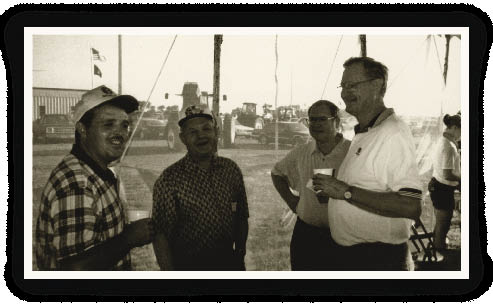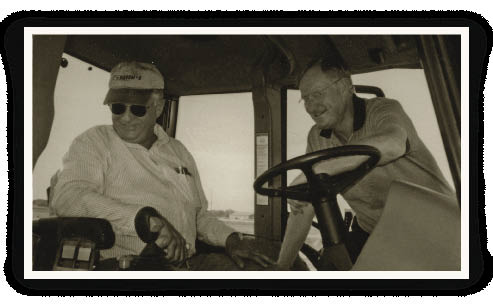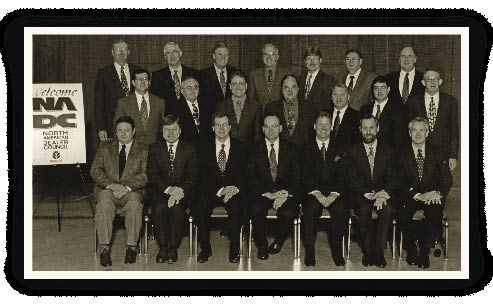
A Quarter Century of Change
“With a degree in agricultural engineering, I was on the faculty of Oklahoma State and the Univ. of Nebraska and did contract research for New Holland. Eventually, I went to work for them full time in 1979. While I was in product development, I became very acquainted with dealers, and from 1996 until I retired in 2004 I had the responsibility of managing our dealers in the U.S. and Canada. During my 25 years with the company, I saw the number of our dealers drop by probably 50%. There’s no question that dealers today are much stronger businessmen than when I first started with New Holland.
Allen Rider, Retired Vice President, New Holland North American Agriculture
Career: “I’m an old farm boy who was raised in northeastern Colorado,” is how Allen Rider describes himself. But this “old farm boy’s” career included earning undergraduate and gradu- ate degrees in agricultural engineering from Colorado State Univ., and a doctorate from the Univ. of Illinois. He taught and conducted ag research at Univ. of Nebraska and Oklahoma State Univ. until he was lured away by New Holland to put his ag engineering background to work in the “real world.”
Between 1979, when he joined the company, and 2004 when he retired, Rider worked in product development, managed New Holland’s engineering, had global responsibility for hay tools and skid steer loaders, and eventually became the company’s vice president of North American Agriculture and oversaw the development of its dealers until he retired in 2004.
Since his retirement, Rider has been on the steering committee of the 25 x 25 renewable energy program. “The goal is to produce 25% of all energy used with renewable resources by 2025,” he says. “The one thing that’s been different in the crop business the last five years, has been the biofuel industry. It’s provided another market for grain, enhanced the profitability of agriculture and business for many dealers. A lot of their sales have been driven by ethanol and other biofuels.”
“Like many of the farmers who disappeared, the difficult business conditions of the 1980s weeded out many of the dealers who were simply not financially stable enough to survive.
“One of the things that really drove changes with dealers were those farmers who survived the ‘80s and became much more demanding. They were looking to reduce the labor content of farm work. That drove manufacturers to build larger, more productive equipment.
“Hyraulic applications were increased and enhanced and eventually all of that led to the electronics we’re seeing today.
“All of this resulted in the need for dealers to stress service and parts a lot more than before. Ultimately, the winner was the dealer that had the best customer relations, the best performance in the marketplace. The product is important, don’t get me wrong, but the driver in any community is the dealer. He has tremendous influence on the success of the brand.”
Increasingly Sophisticated
“All through my 25 years with New Holland, several factors pushed dealers to where they are today, which is far more sophisticated as business people. Those with good skillsets survived. This led them to be much stronger when it came to capitalization.
“Early in my career, smaller dealers could survive without the level of capital that’s required today, but they couldn’t survive the downturns.
“As dealers’ business skills improved, this set the stage for growing the capabilities to acquire and manage the multi-store dealer groups that you’re seeing today. This clearly provided the dealer with an expanded customer base, but also the things that go along with that, like being able to provide a better parts supply because you’ve got a bigger area from which to distribute it.
“As farmers got bigger, it also forced dealers to grow their service capabilities. What they’re able to do today is significantly better than what they were before, and this set the stage to support the electronics we’re seeing in farm machinery today.
“Another thing that set the best dealers off from those that were pretty good was handling used equipment inventory. All the good dealers can sell new equipment, but those who learned to plan for it and maintain good cash flow were the real success stories.
“Also, a mistake in evaluating the value of a used product in the old days was not as traumatic as it is today. If you make a mistake in the business today, it’s huge in terms of the bottom line. It has changed dramatically from that standpoint.
“Speaking from the old New Holland perspective, I remember a dealer I was working with on the combine side of the business. He said, ‘I can sell the new combines overnight, but that’s not where I start the process.’
“I first take a hard look at the first, second and third turn of that used combine. I figure out where I can go with that used before I start pushing the new because I can’t afford to have a lot of used inventory.’
“That’s when I saw what it was going to take for dealers to succeed in the future. The best ones became much more skilled with more business savvy. We all know this now and the business condition we’re operating in today requires that all dealers better understand and plan trades before they take them in on trade.
“The other thing that’s emerged that dramatically changed how dealers do business is use of the Internet. The Internet was a non-event when I started in ’79. Today, it’s an absolute necessity. I know not all dealers are utilizing it effectively, but many are better able to manage their used inventory using the Internet.”
Managing Human Capital
“Another area where dealers have really improved is managing their human resources compared to my early days. Again, it’s become a necessity.
“When you look back, in many cases dealerships were pretty much family operations with a few outside employees. Today, you’ve got multi-store locations that aren’t family businesses anymore. Managing and working with a large number of people is a major challenge. It’s one of the things the dealers must continue to work on is their human resource and communication skills.

Allen Rider, vice president of New Holland North American Agriculture (rt), shares a coffee with some new combine owners during a New Holland dealer open house (circa 2000). He says his best dealers learned that the first step in selling a new combine was to have a customer waiting to buy the ones they were trading in.
“This applies equally to employees, customers and suppliers. A strong relationship with your supplier is probably more important today than it ever was. Communication skills and the requirements on a dealer are much greater than what they were when I joined the industry. As farms get larger, they’re becoming more demanding and their expectations are greater.
“These customers are looking around at the automotive or electronics industries and say, ‘They can do it, so can you. That’s what I expect from you.’”
‘Natural’ vs. New Market Share
“When it comes to market share, I always felt there were two parts to it.
“The first is what we used to refer to as kind of a ‘natural market share,’ which our product and our dealers in given areas would naturally get. We watched that because that was an indication to us of the level that we thought we ought to be in a given area. If we weren’t in that area, it indicated to us that maybe our product wasn’t quite right or we weren’t doing the right thing or maybe the dealer wasn’t doing quite the right thing.
“The other way people look at the market share, is that it’s something to grow, grab or buy. Quite honestly, that’s not a very successful long-term strategy. I always believed the best strategy was to provide the products, service and support that generate that natural market share. Sure, over time you can continue to grow that a little bit, but going out and basing everything on market share is absolutely not an effective strategy for long-term success.
“We watched it, but we watched it maybe for a different reason than what some companies do today. If you look at it as, ‘Boy I’m just going to grab every bit I possibly can,’ my experience was that high-end market share is not as profitable as natural market share.”
Selling New is Easy

At a customer event in 2002, Allen Rider, vice president of New Holland North American Agriculture (rt), talks about the features of the company’s newest offering in its Ford Genesis tractor lineup.
“Some dealers will be mad when they hear me say this, but selling new equipment is probably the easiest part of the dealership business.
“The thing that makes the dealer successful and keeps the dealership solvent is providing service, parts and moving used equipment. That’s really where the challenge is and that’s where you really make the bottom line come through for you. It’s those elements that drive the success of the dealership for the long term.
“We always looked at the dealership’s absorption rate. It’s an important criteria because, the fact is, if you don’t have a good absorption rate, you’re not going to be successful long term. This is particularly true when things turn down.
“If you look at it realistically, when equipment sales are down, what do you have to make your business profitable? It’s the service and the parts business that drives it and keeps you going. So you certainly need to have the absorption to be able to cover as much overhead as you can, there’s no question about that.”
Two Sides to Dealer Purity
“This is my opinion when it comes to dealers only carrying their major supplier’s products because I don’t know what New Holland’s position is today, but the reality of it is you want your New Holland dealers to concentrate on New Holland products.

This group photo shows New Holland’s North American Dealer Council in 2000. “During my 25 years, I saw the number of our dealers drop by probably 50%,” says Allen Rider, vice president of North American Agriculture. “There’s no question thatdealers today are much stronger businessmen than when I first started.”
“To insist on purity is just great. It’s wonderful if you can have that because you know they’re concentrating totally on your equipment and you don’t have what I’d call ‘internal competition.’
“But the reality of it is, in the environment in the market where your dealers operate, they must look for products to fill holes in your product line where they exist. There may be some special equipment that they need to satisfy their customers. At the same time, dealers are individual business guys and they have to determine what’s required to satisfy their customer base. That’s the way dealers need to look at it.”
The Next Challenge
“With my background in engineering, my greatest satisfaction was putting a new product out there that met customer demands, that performed to their expectation levels, and had a good reliability and durability record. To me, that was a great success.
“And it was great success not only to the company, it was great success to the dealers because if they had a product, and something that they could count on, it made it a lot easier for the dealer to go back out and talk to a customer. It’s always a challenge to maintain customers when the product they purchased don’t meet their expectations.
“The electronics era really came in while I was in engineering and that was a major, major issue. And, of course, electronics only continues to change the industry. It went from initially helping the machine perform a little bit better to today where you have precision farming providing a whole variety of things and better utilization, not only of the product, but of the land and other resources.
“This is all putting more stress on dealers, and it goes along with what I discussed earlier about customer expectations. And this will be the industry’s next big, big challenge because the dealer must be comfortable with it before he can help his customer get comfortable with it. The dealer must relieve his own stress with new technology. But the best dealers will do it. They always have.”






